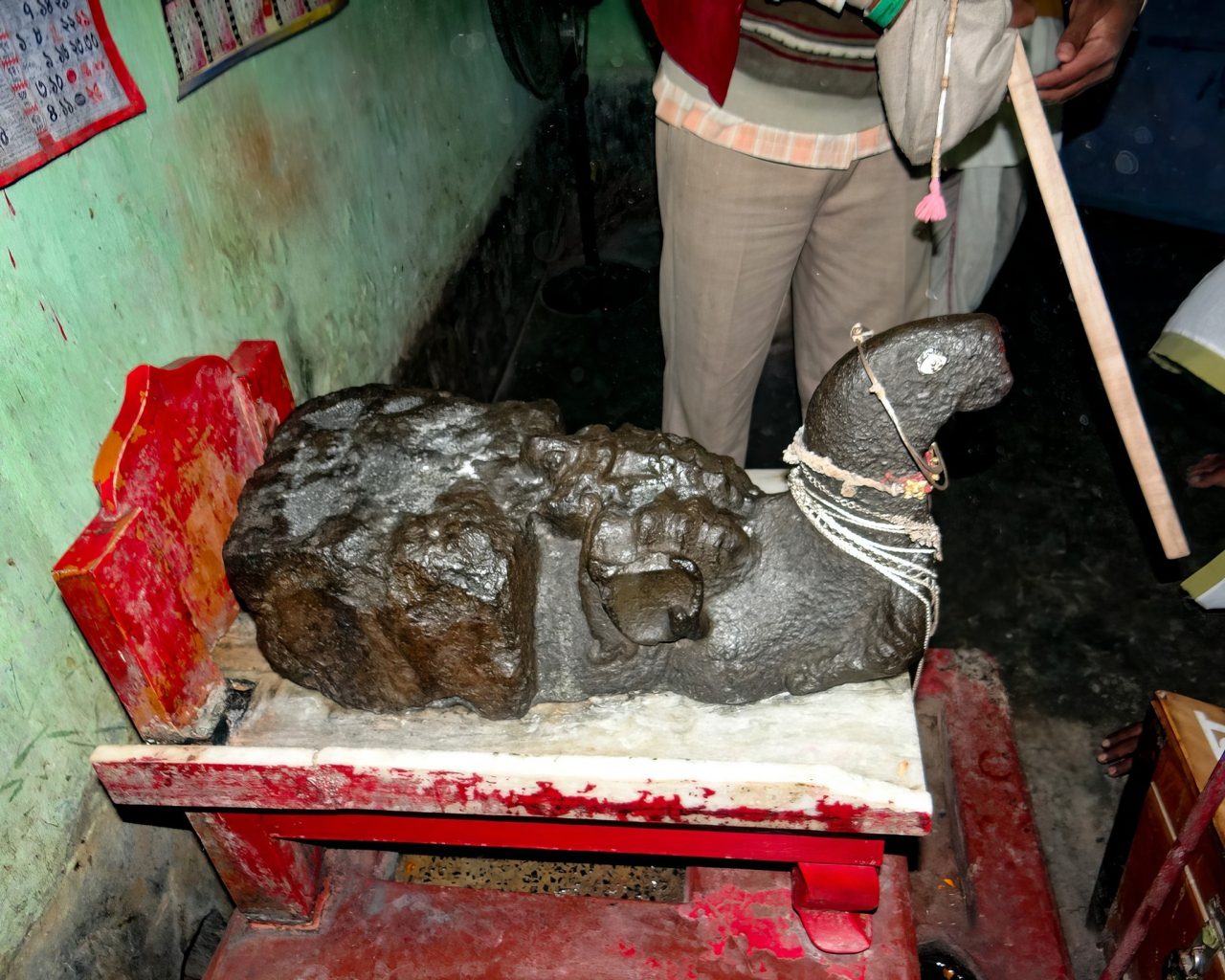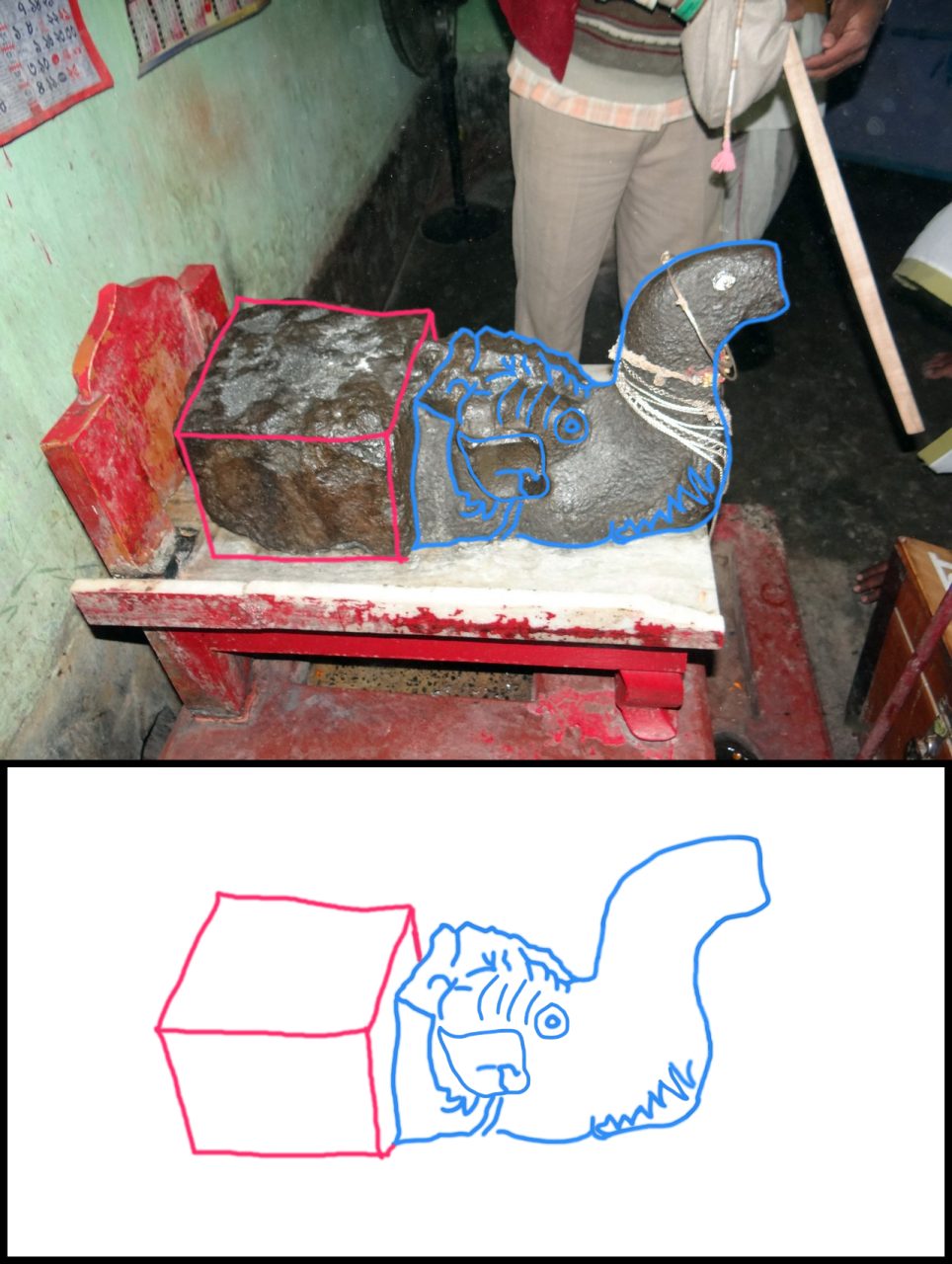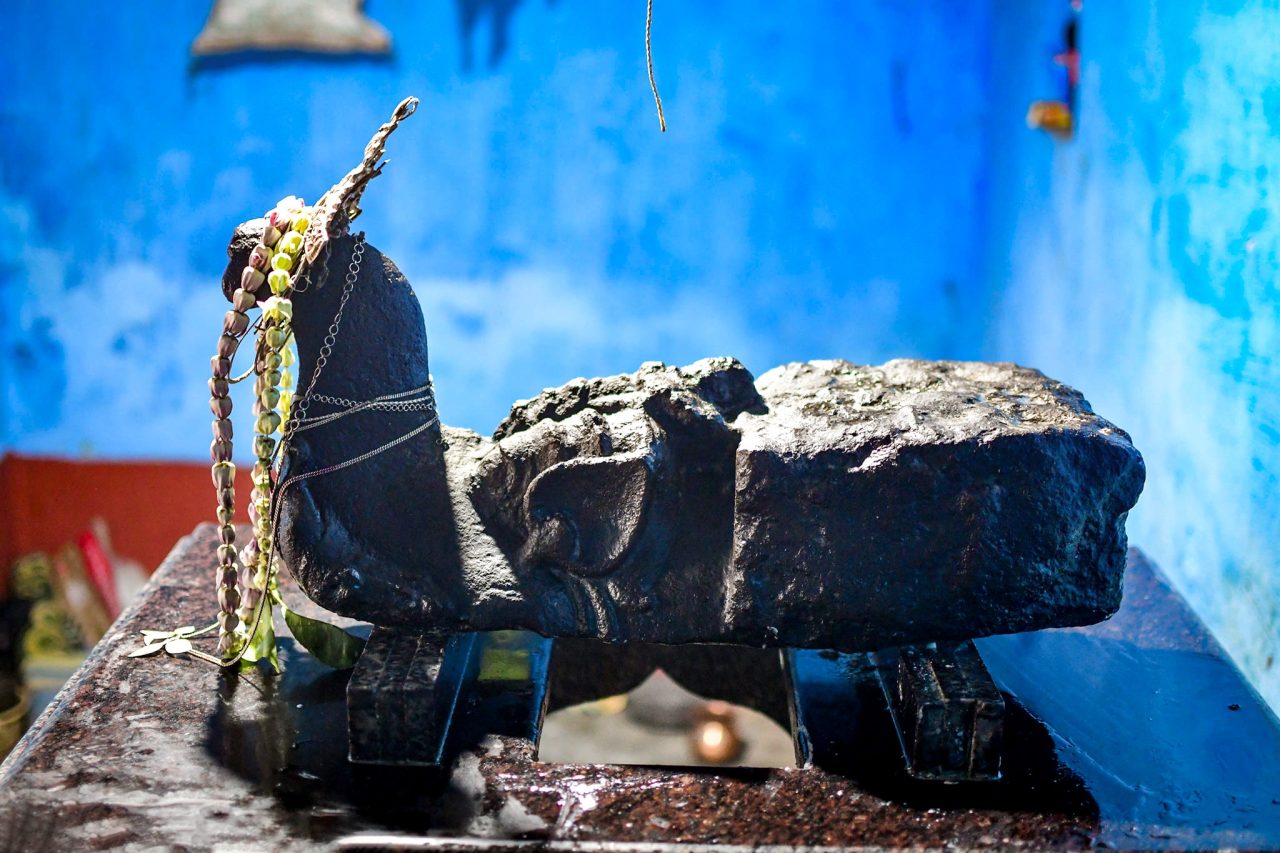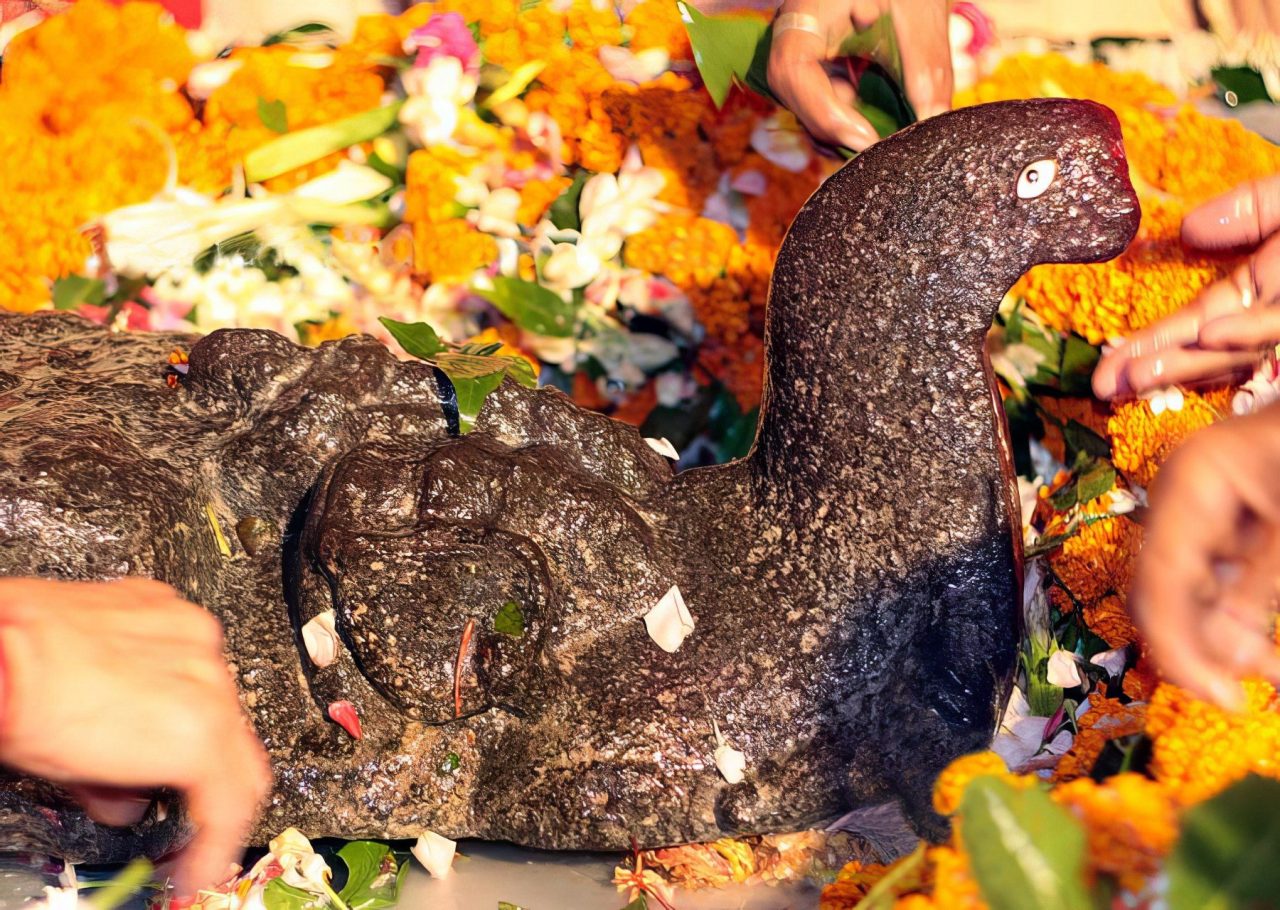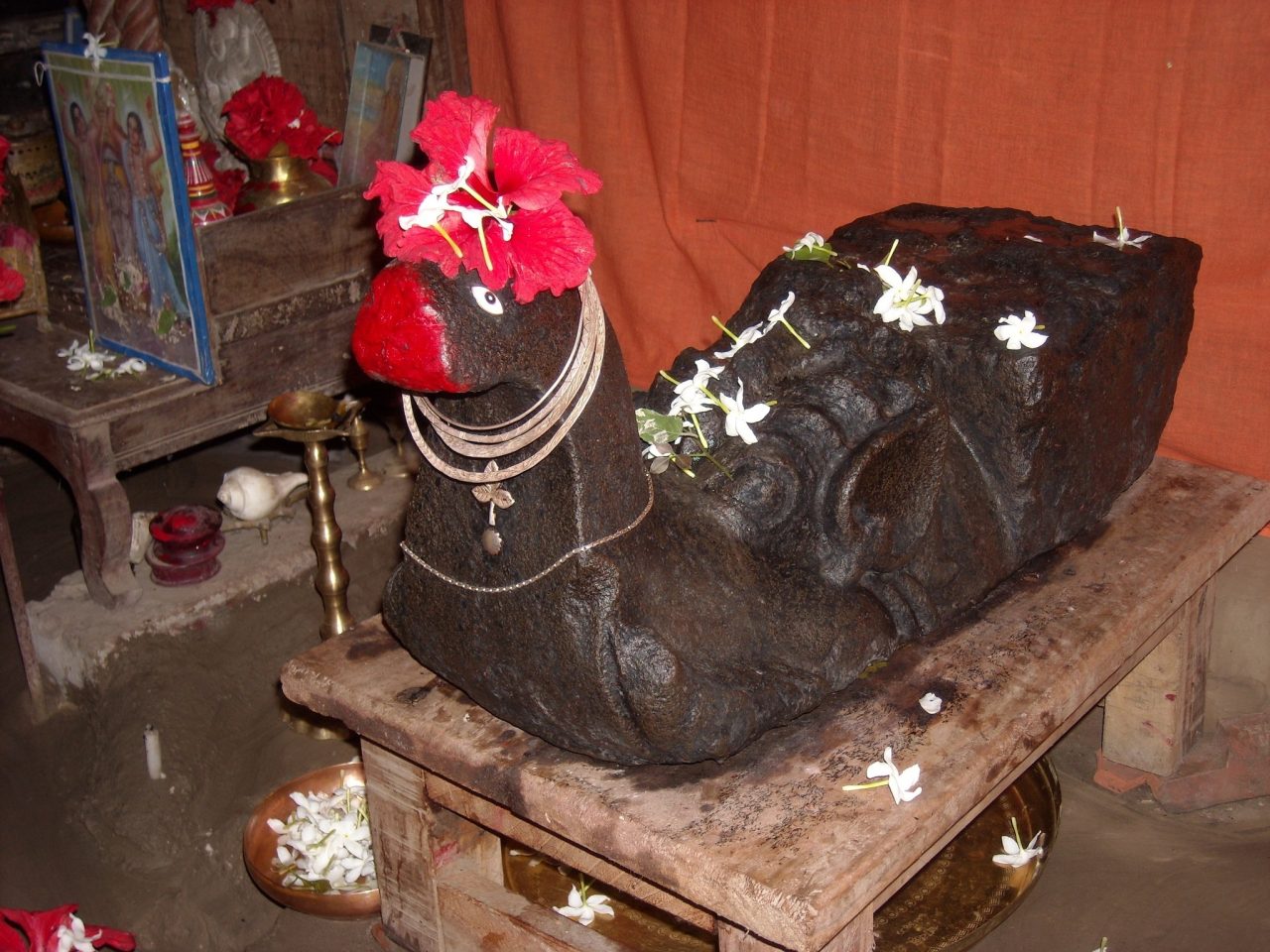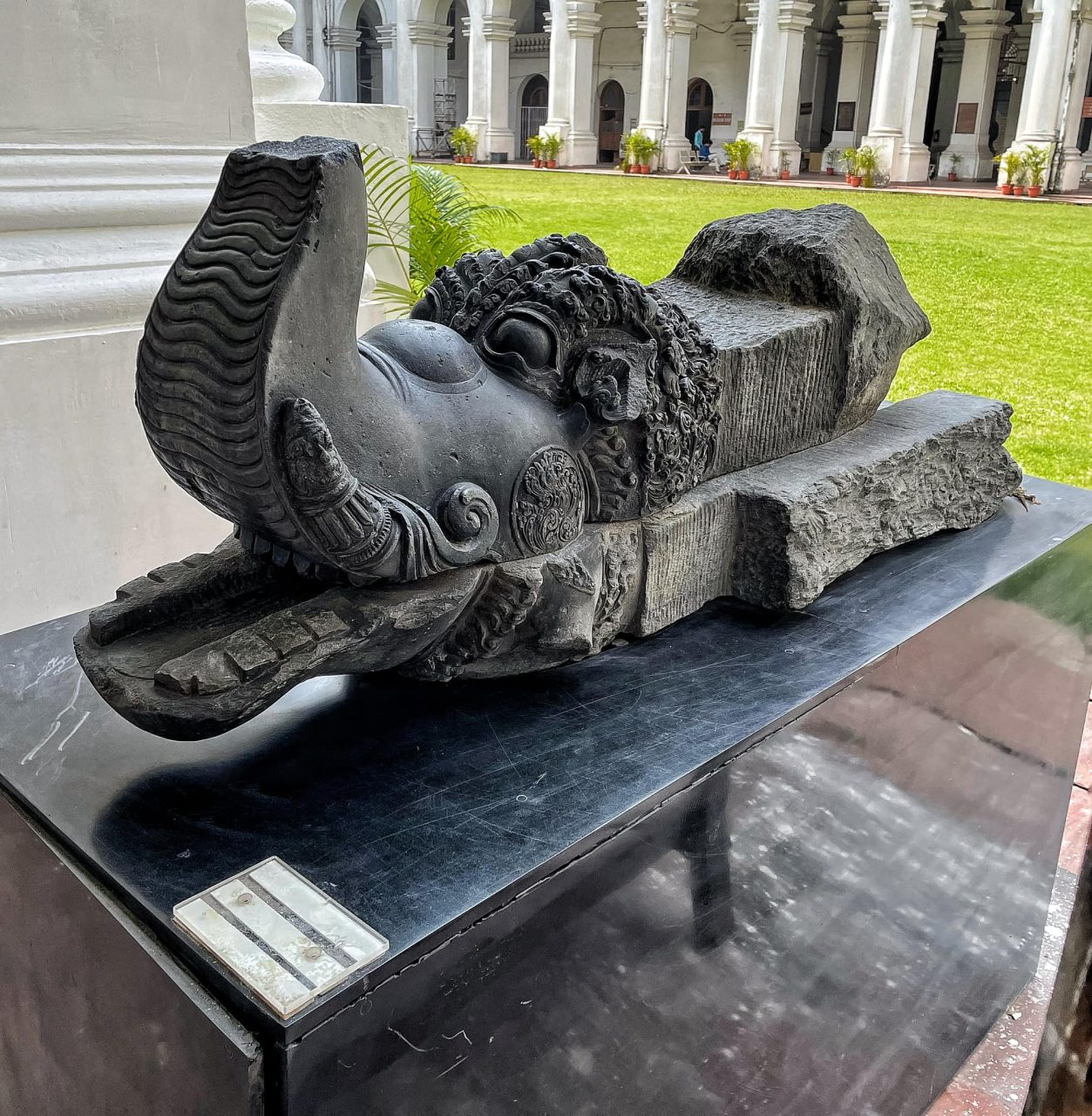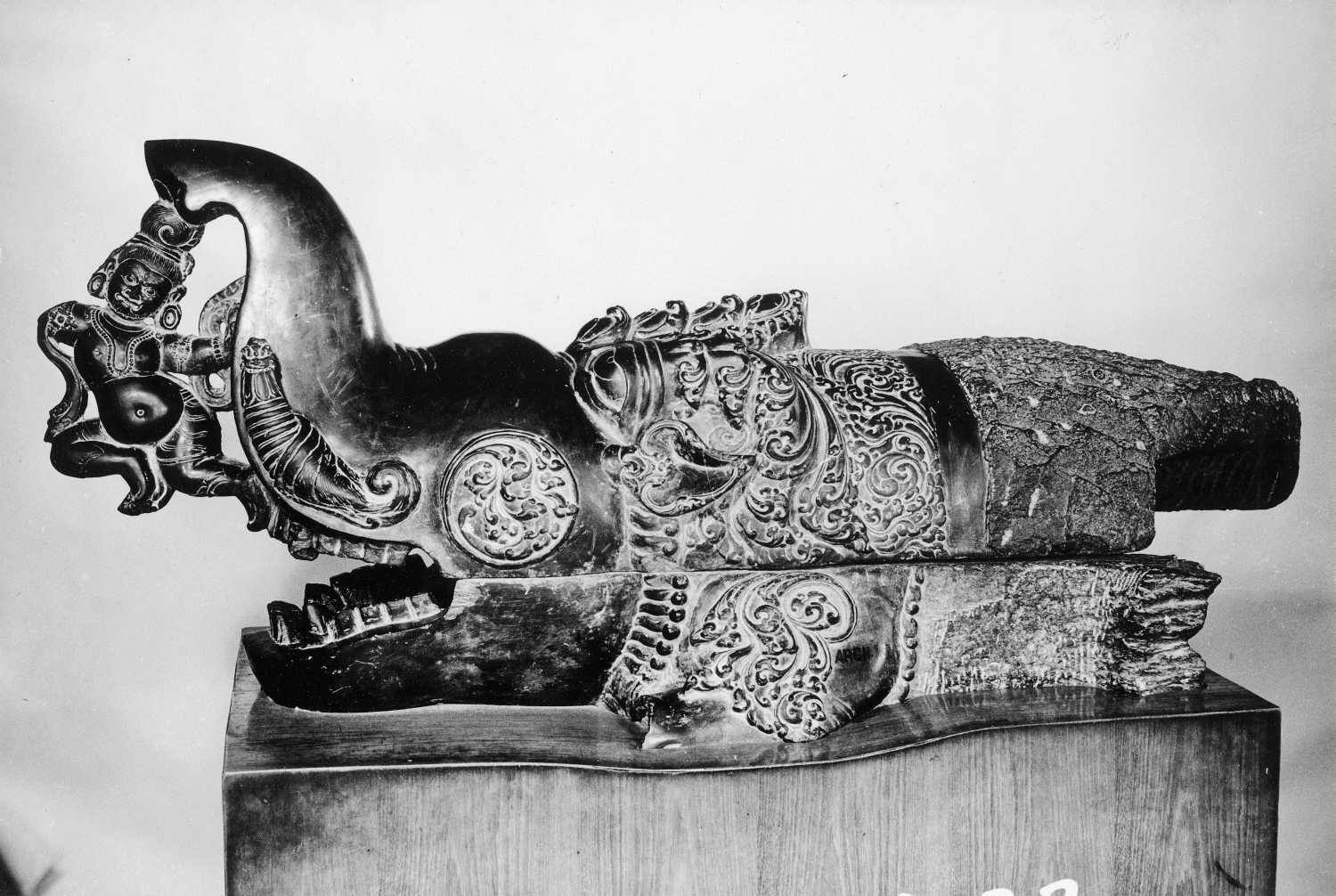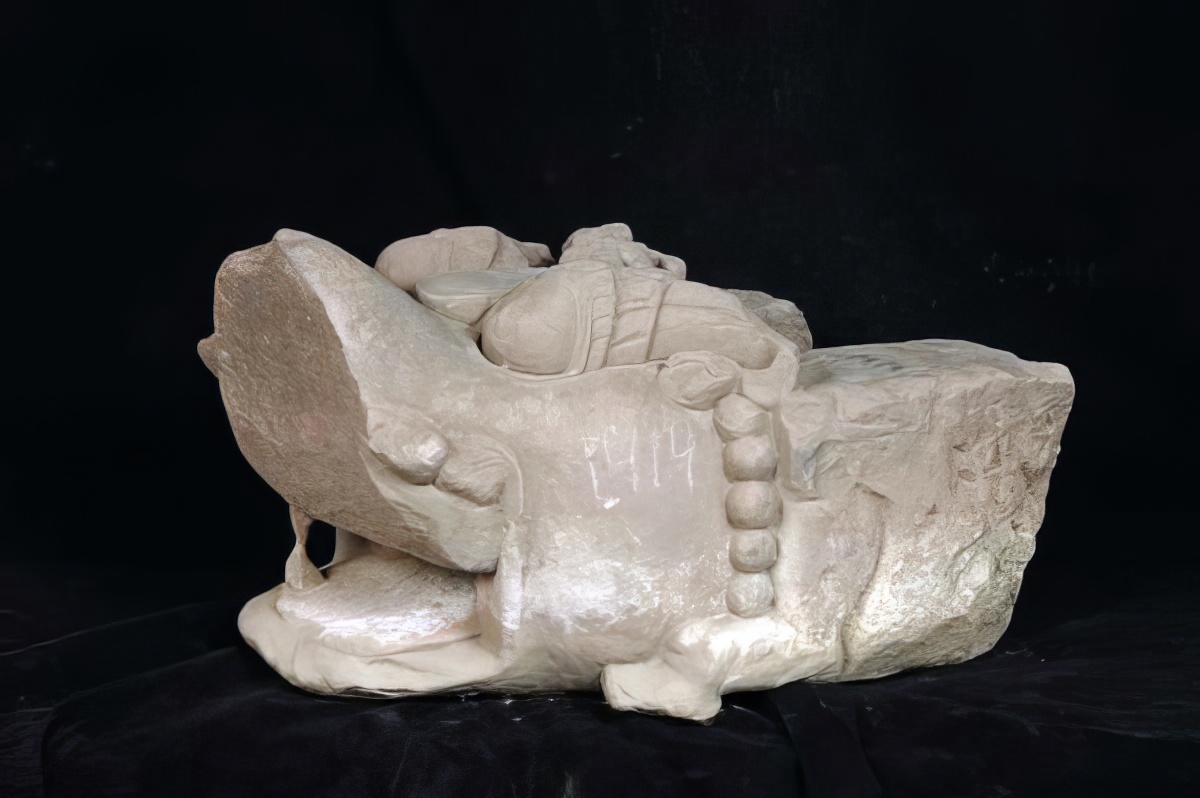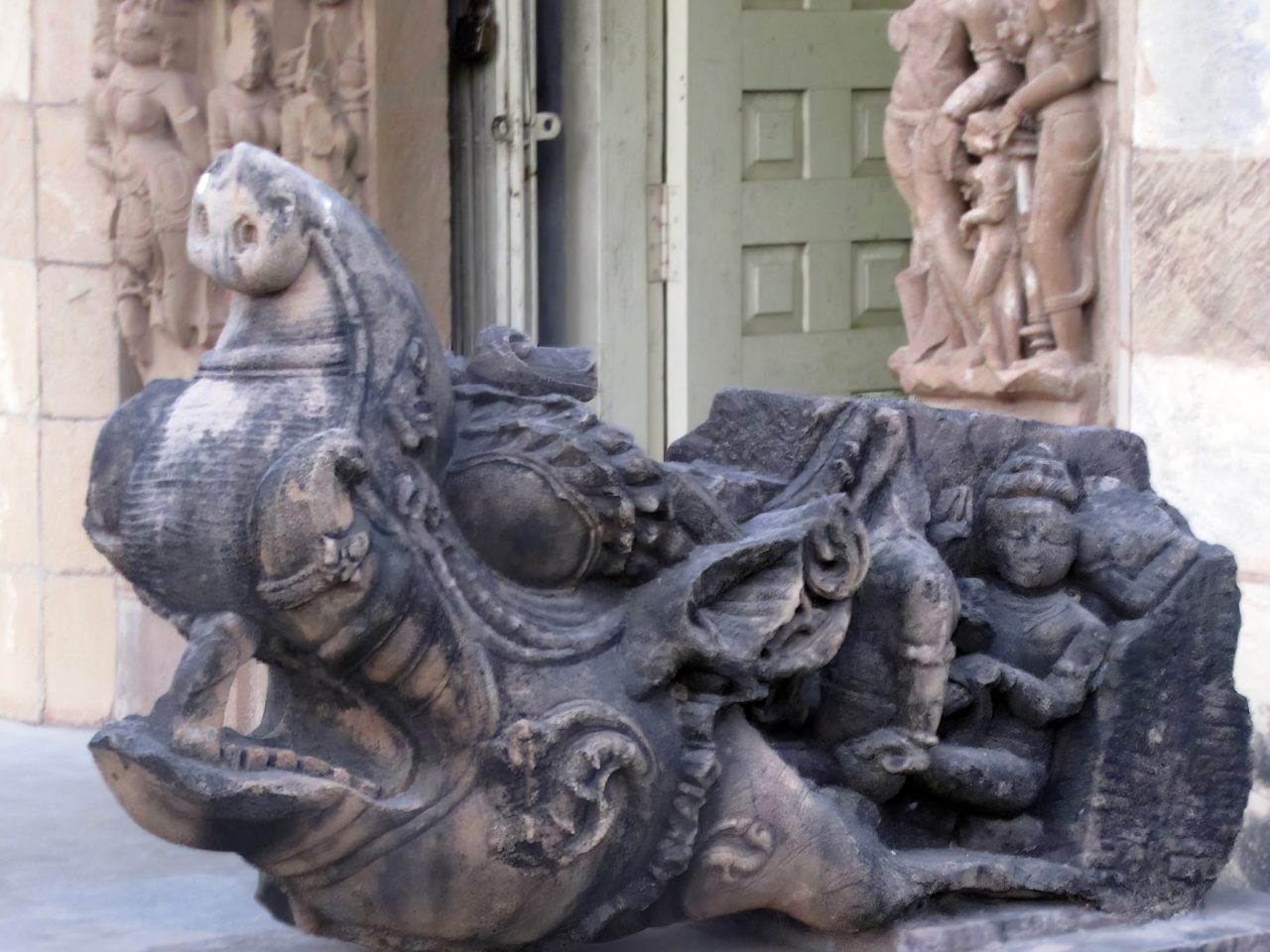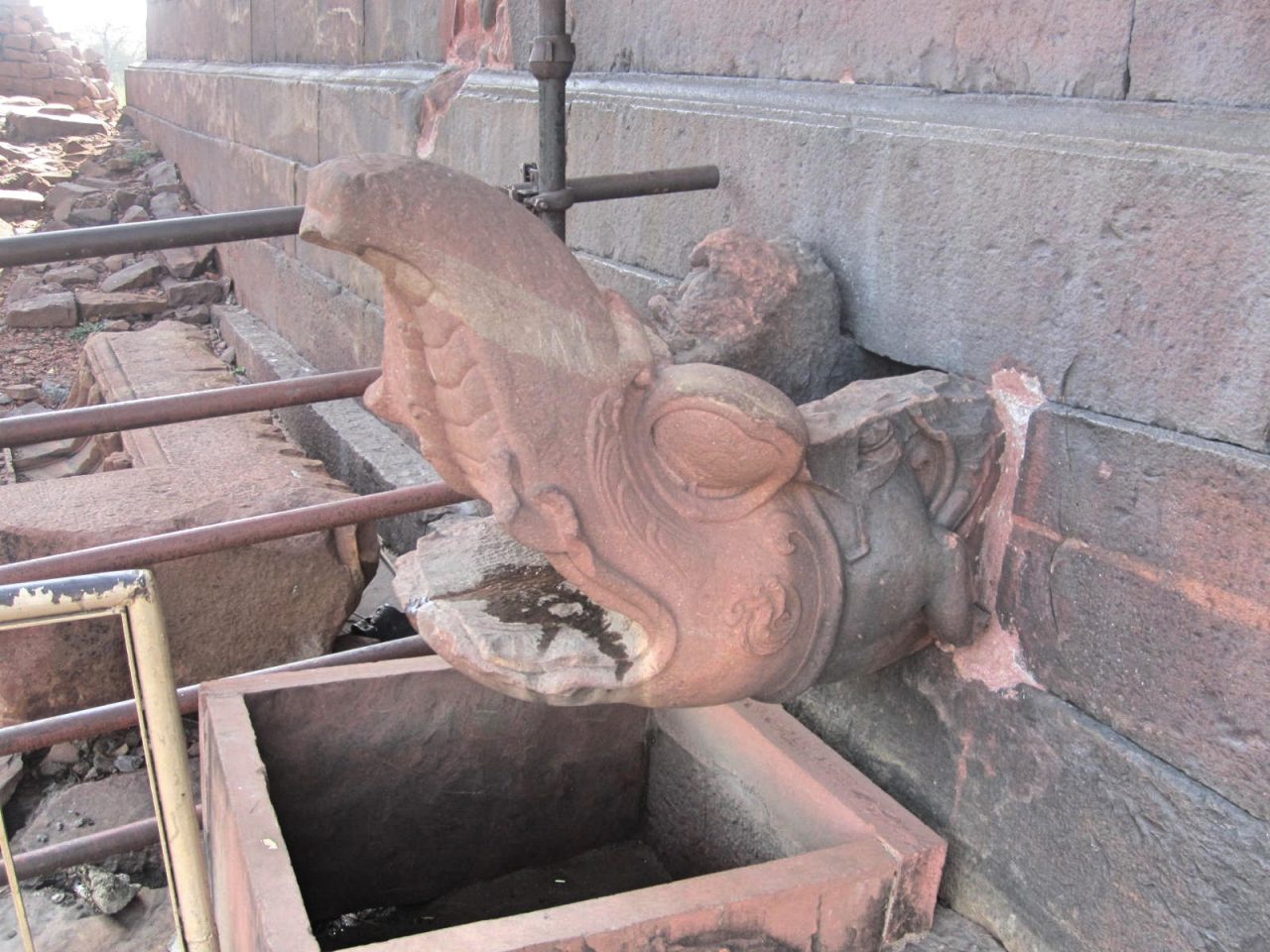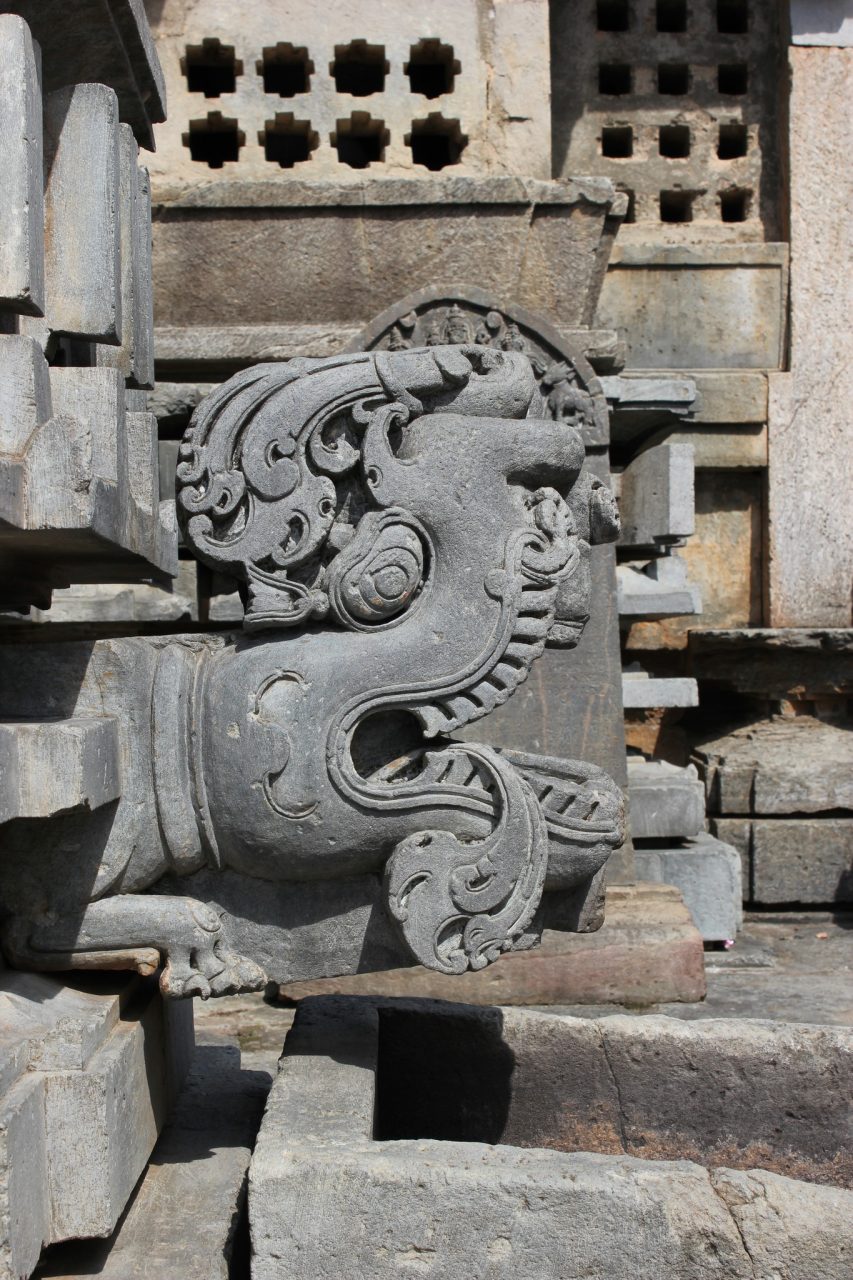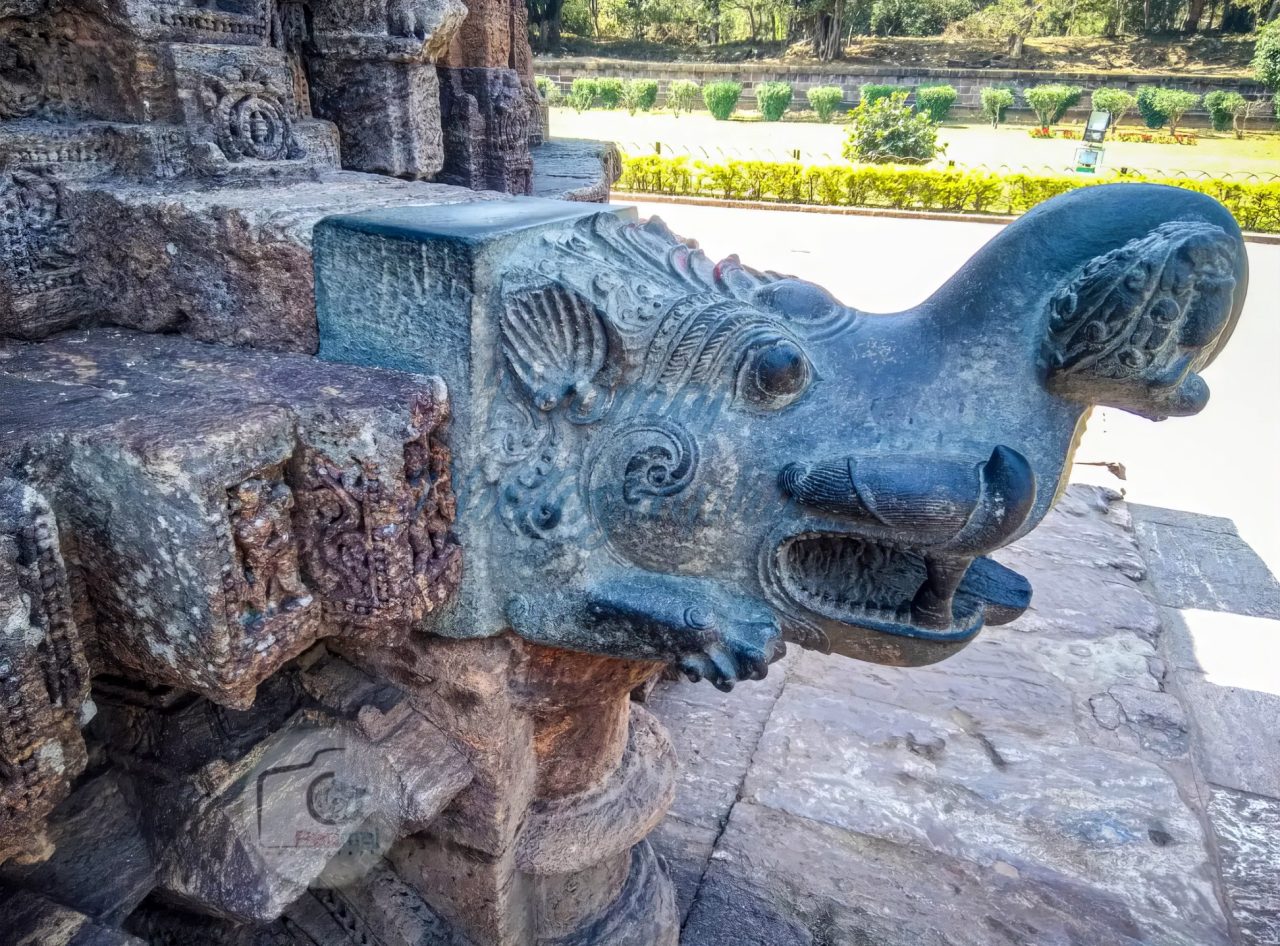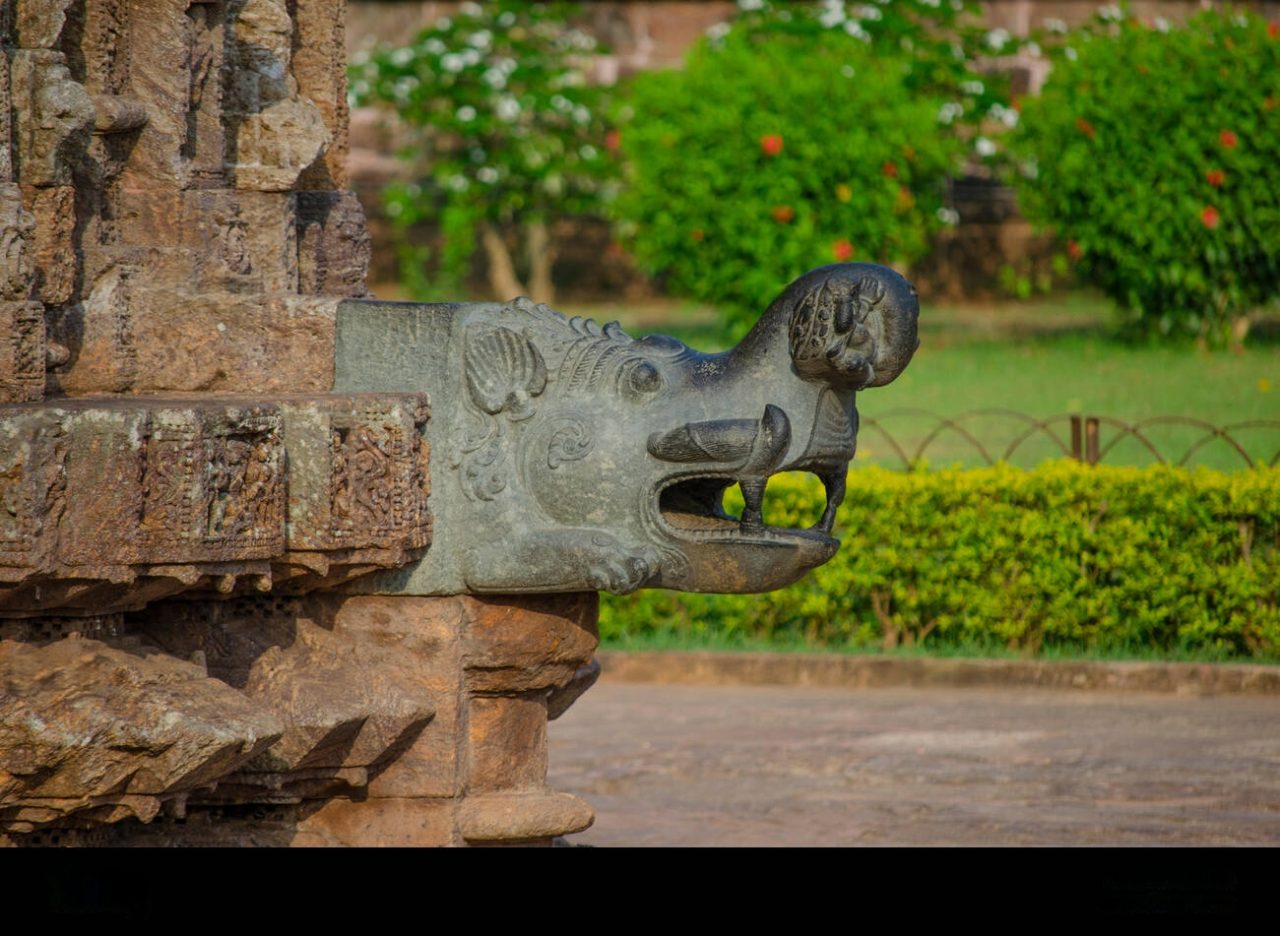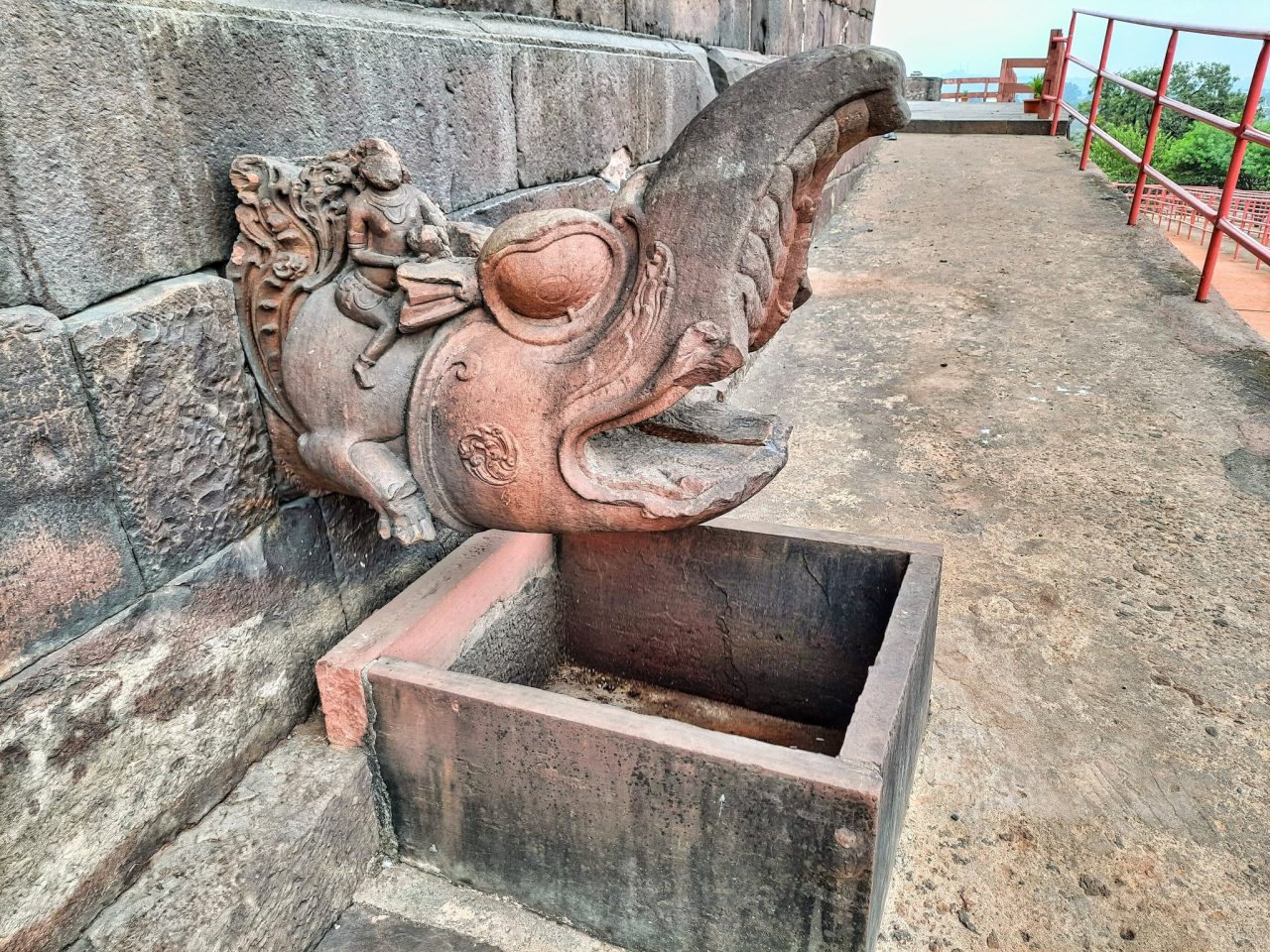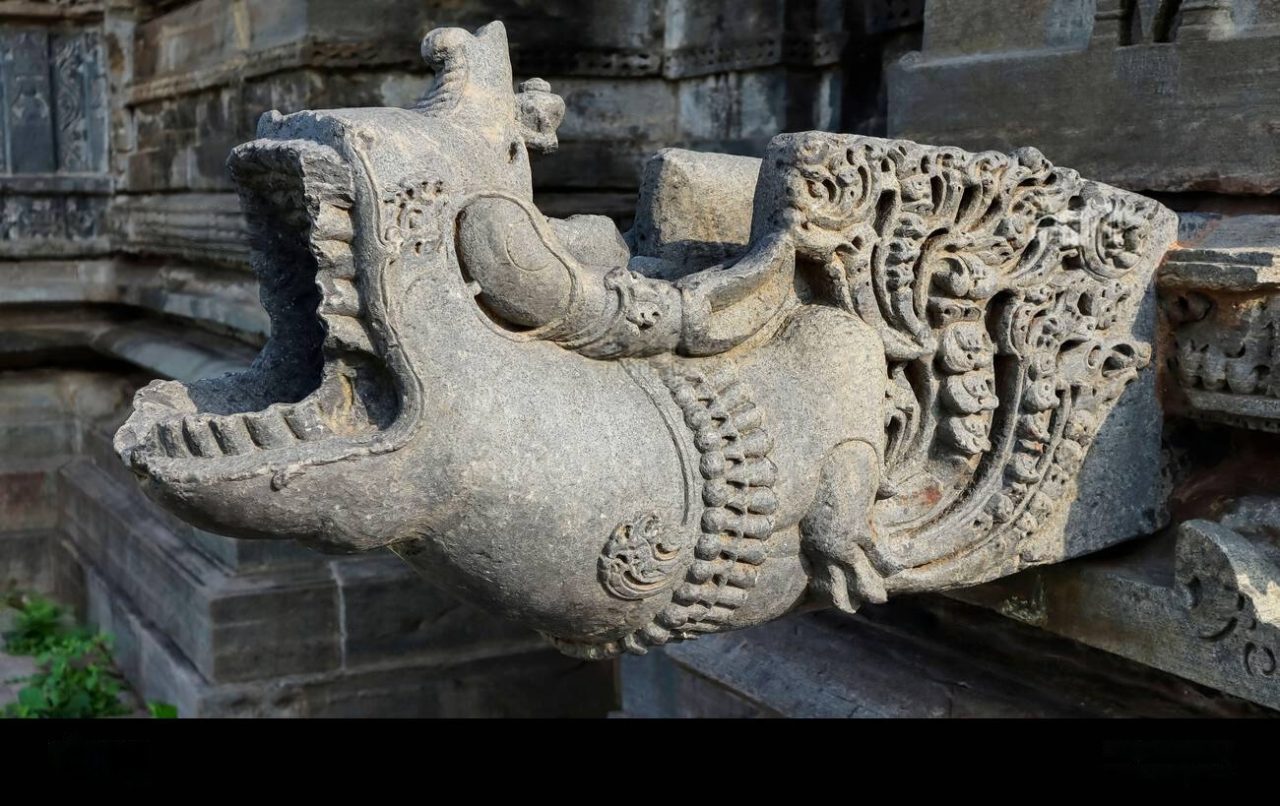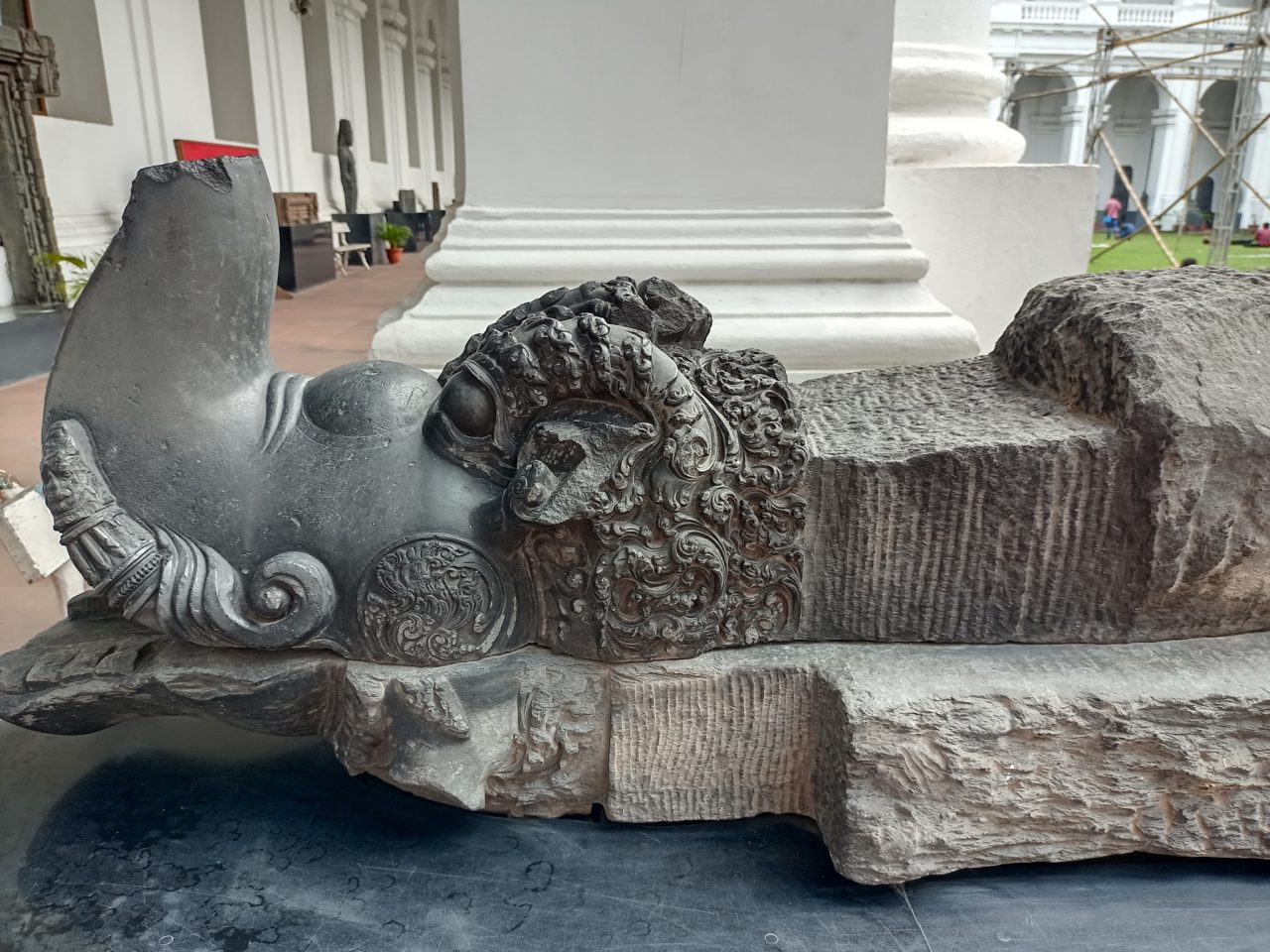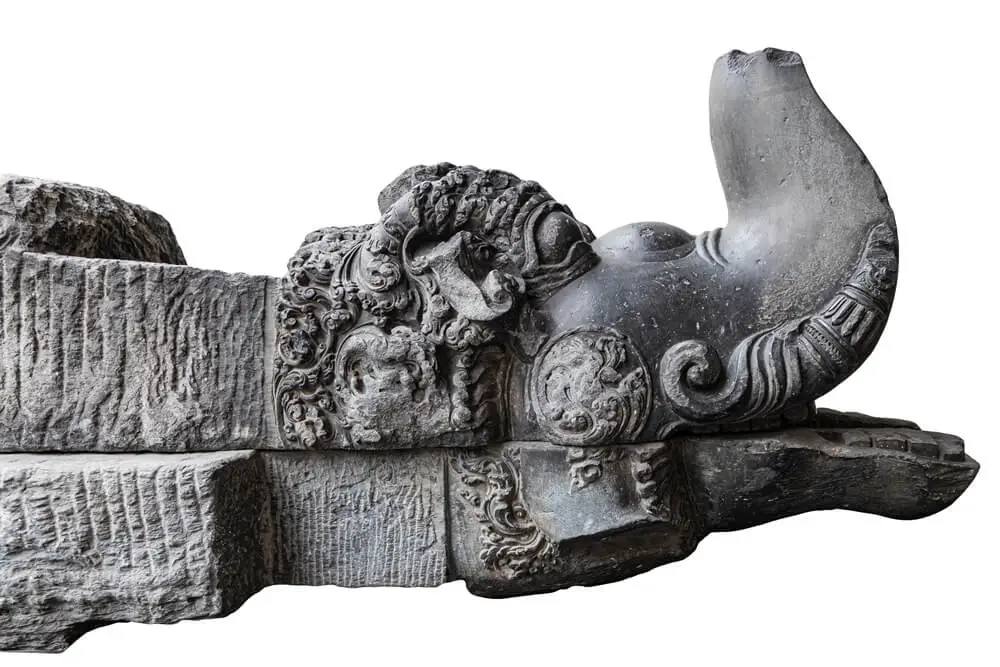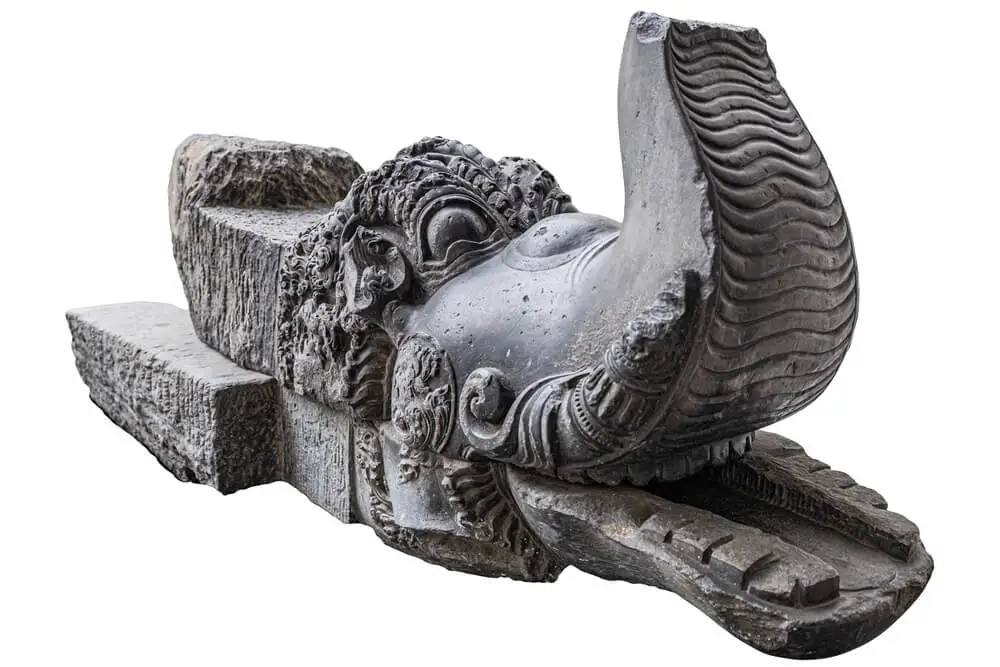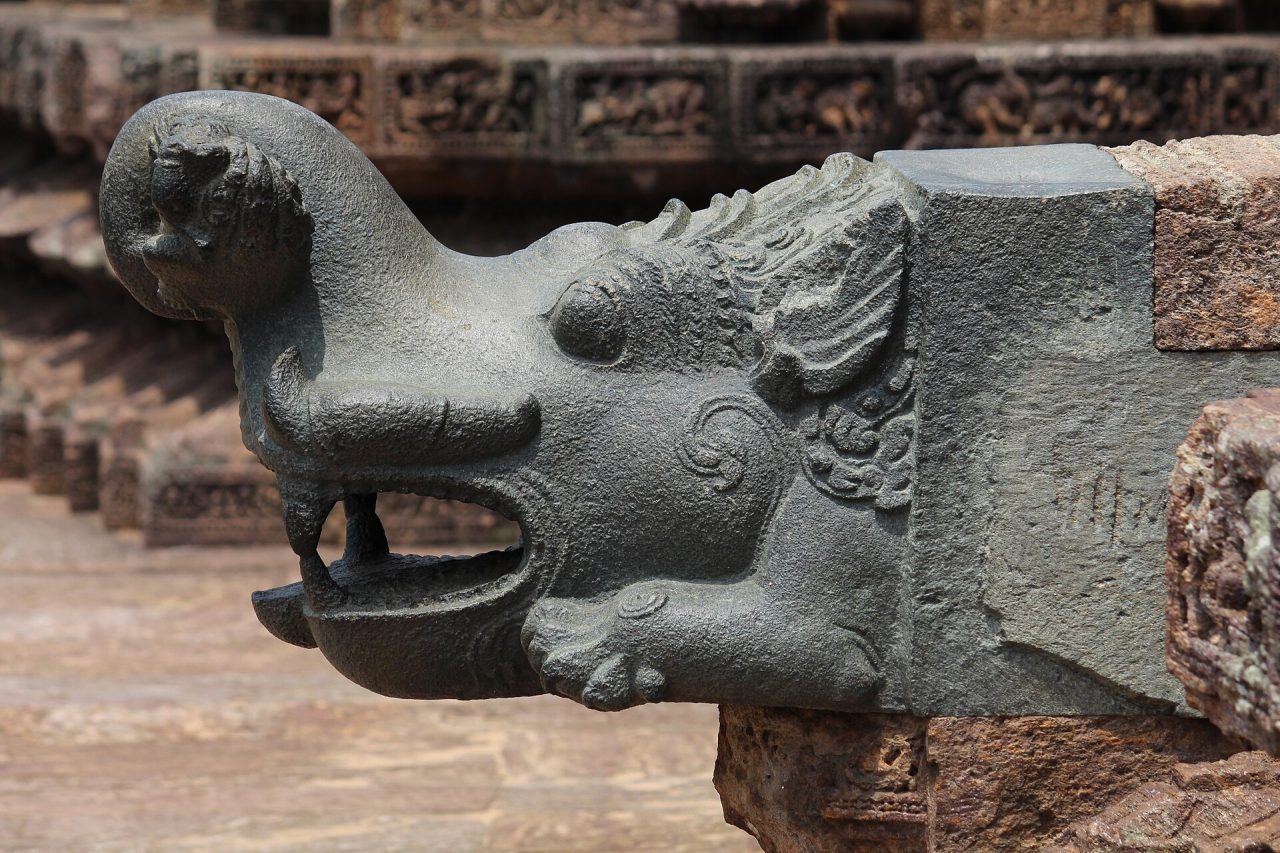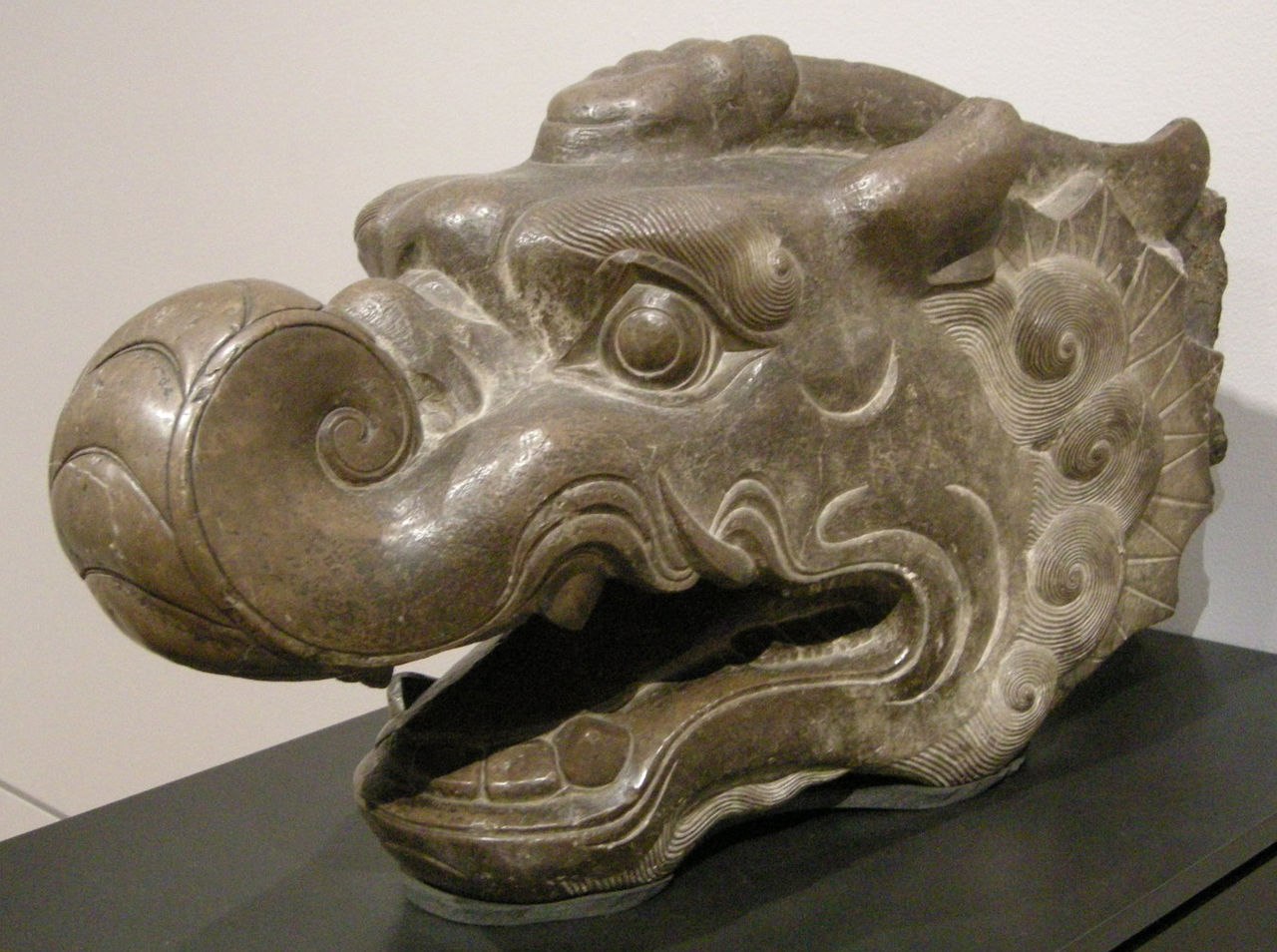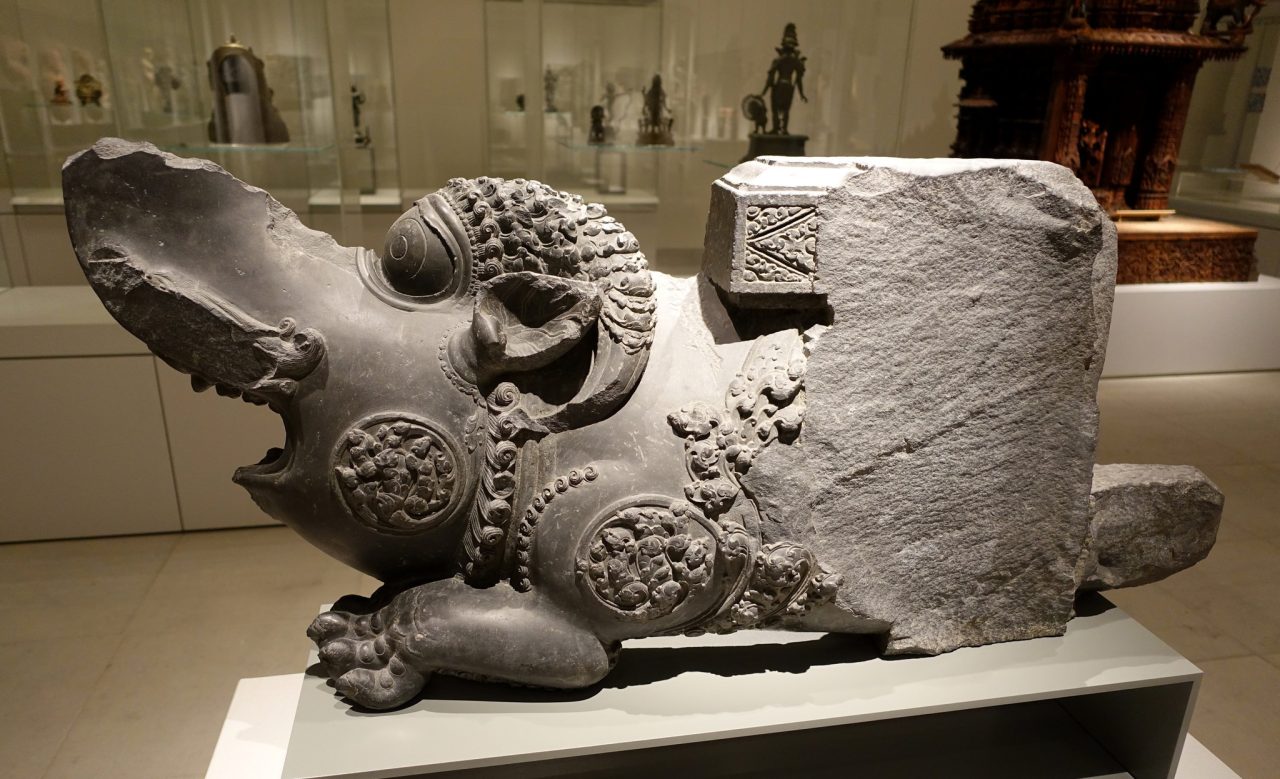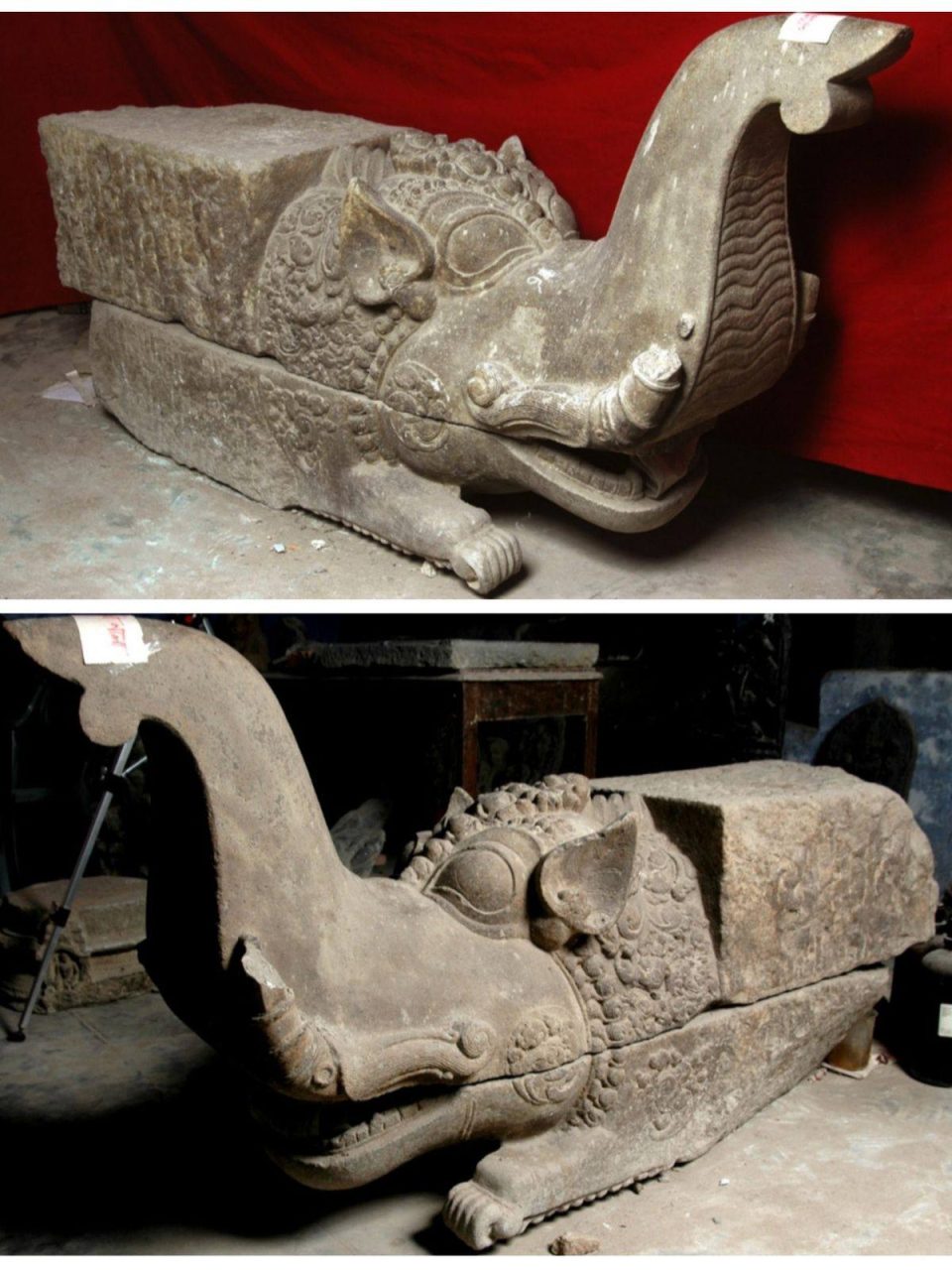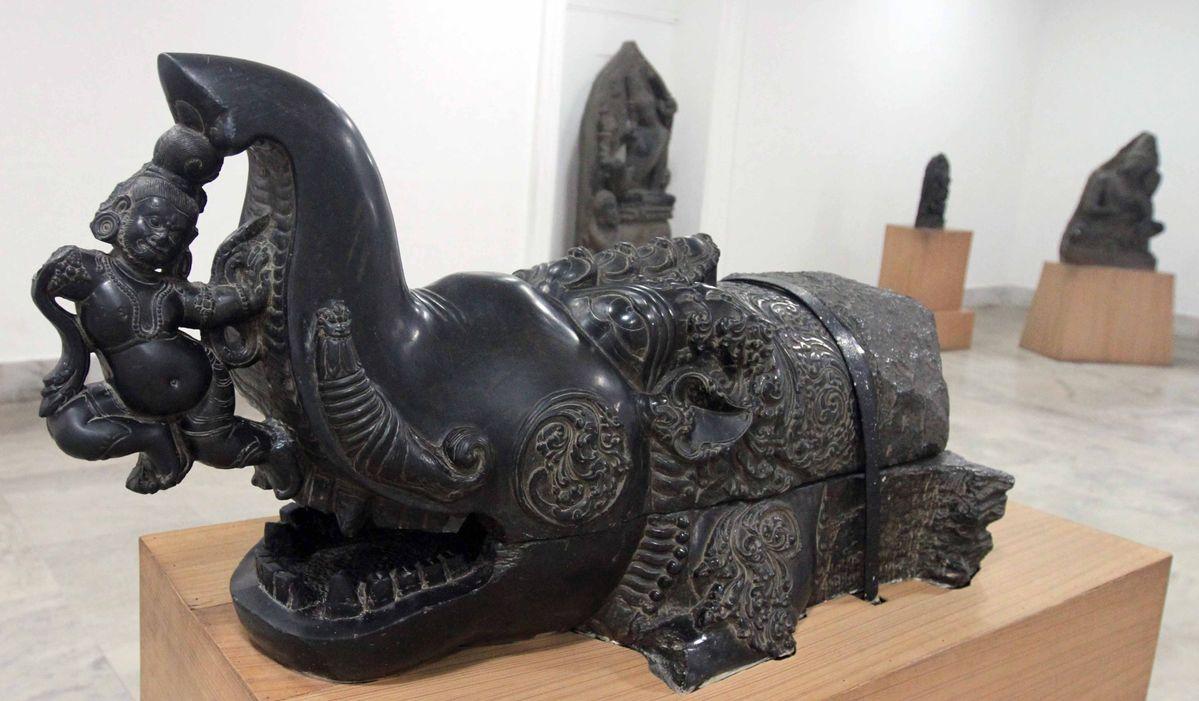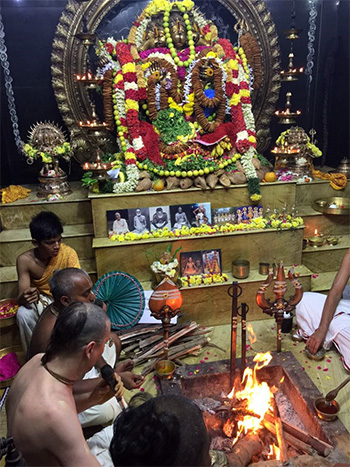It is a fact that the deity known as Hamsa Vahana in Mayapur is not a deity of Lord Shiva nor that of a Hamsa. It is the remains from a destroyed temple and was originally a water spout carved in the shape of a Makara (half elephant, half crocodile). Its very clear if you look at the carving up close. All of the features are very obvious and distinct.
This piece of architecture is known as “Makara Pranala”, and is common in ancient temples. The carving was once a decoration in a temple wall, and that is why the back portion is rough and square, as it would sit inside a granite wall like a brick, with the face protruding outward. The carved portion clearly has the eyes, ears, mouth and trunk of a Makara (half elephant, half crocodile entity).
I remember 30 years ago devotees used to spread a story that the deity stays in a lake and once a year the deity mystically flies out of the lake on its own and enters the temple for worship. The story seemed ridiculous and I never saw any evidence that this deity moved on its own as they used to claim. In hindsight its clear that not only was the story made up, but the “deity” itself is not even a hamsa at all.
The “deity” used to be neglected and kept under the water of a lake the entire year, and then for a week or so they brought it out “for worship”. It didn’t even have a temple or proper worship established. Over time they have built a temple for it and in recent years they even started taking it to other temples like ISKCON to put on display. The entire thing is based on a mistake and misunderstanding, and its growing like a snowball each year.
Still, it is true that whereever you worship Lord Vishnu or Lord Shiva the Lord will manifest there and accept the worship. There is no harm in worshipping it even if it was a Makara decoration in an old temple, but the fact remains it is not a deity of Lord Shiva in the normal sense.
Above you can find closeup photos of Hamsa Vahana, and below you can see many examples of Makara Pranalas from other temples and ruins. The obvious conclusion is that this is not a deity of Lord Shiva, and the entire thing has been based on a misunderstanding. It is better to correct this problem now before it keeps growing over generations.
What should be done now? A proper shivalinga should be installed at the temple with necessary rituals to transfer the presence into the shivalinga. Some divine presence will be existing in the Makara stone since worship has been going on for decades. But once the situation is understood it makes no sense to keep worshiping Lord Shiva in a broken temple decoration. There are procedures to establish his worship and transfer the presence.
In Navadvipa Dhama Mahatmya, written by Srila Bhaktivinoda Thakur, the place of Hamsa Vahana is mentioned as follows. Based on this, when this carving was found some people mistakenly assumed it was a deity of Hamsa Vahana:
“To the south of this see one stream, the very pure Gomati River. Beside it is Naimisaranya. At the beginning of Kali-yuga, the rsis headed by Saunaka heard about Gauranga from the mouth of Suta. Whoever reads the Puranas here during the month of Kartika becomes free from all distress, becomes absorbed in the pastimes of Gauranga, and easily attains Vrndavana. Giving up his bull carrier, Siva once mounted Sri Hamsa-vahana, Brahma’s swan, and came here to hear the recitation of the Puranas Along with his followers, he sang the glories of Gaura. While singing and dancing, the followers surrounded Siva, and shouting the name of Gaurahari, threw heaps of flowers all around.” (from Navadvipa Dhama Mahatmya)
Based on that one passage someone misunderstood this carving to be a deity of “Hamsa Vahana”, and slowly the story has gotten bigger and bigger, especially due to ISKCON and the yearly Mayapur parikrama.
The following is an article from Back to Godhead magazine in 1993 where the story of Hamsa Vahana first started being promoted in ISKCON:
“The worshipers of Hamsa-vahana say that the deity is always extremely hot, so they must keep him continuously covered with water, like the core of a nuclear reactor. That’s why he stays submerged in a lake. On the twelve days in April when Haàsa-vahana comes out to be viewed in the temple, water is poured over him nonstop, around the clock. Otherwise he would heat up and start smoking. All day and all night long queues of people waiting to bathe Hamsa-vahana stretch through the village streets. Popular opinion holds that Hamsa-vahana is hot from anger (as Siva exemplifies destructive rage), but the truth is that the heat arises from Lord Siva’s intense love for Lord Caitanya.”
In that passage you can already see some examples of the exaggeration and mythological stories they made about the “deity” that I clearly remember from around that time. They would say the deity was heating up, and needed to be covered in water or it would burn everything, when the reality was they put it in the lake for practical reasons because there was no temple and no pujari and it was a newly found thing without much support.
The stories were even much more exaggerated than that. They used to say the deity flew mystically on its own out of the lake once a year, which wasn’t true. Everyone repeated and spread these made up stories without anyone thinking logically or asking where is the proof for any of that.
From the writings of Bhaktivinoda Thakur we know there was a place where Lord Shiva performed this lila of riding on Lord Brahma’s Hamsa vahana, but at the time of Bhaktivinoda Thakura there was no temple existing and no deity. Even in 1993 when I first came to Mayapur there was no temple and the carving was just left in the lake all year. At that time they had just started with the stories. Pieces of broken temples are found all the time in Bengal because nearly every single temple had been destroyed in the past.
Now 30 years later Hamsa Vahana is no longer “getting hot” or “burning up the universe”, nor is he magically flying in the sky once a year as the stories used to claim.
TEST-2
